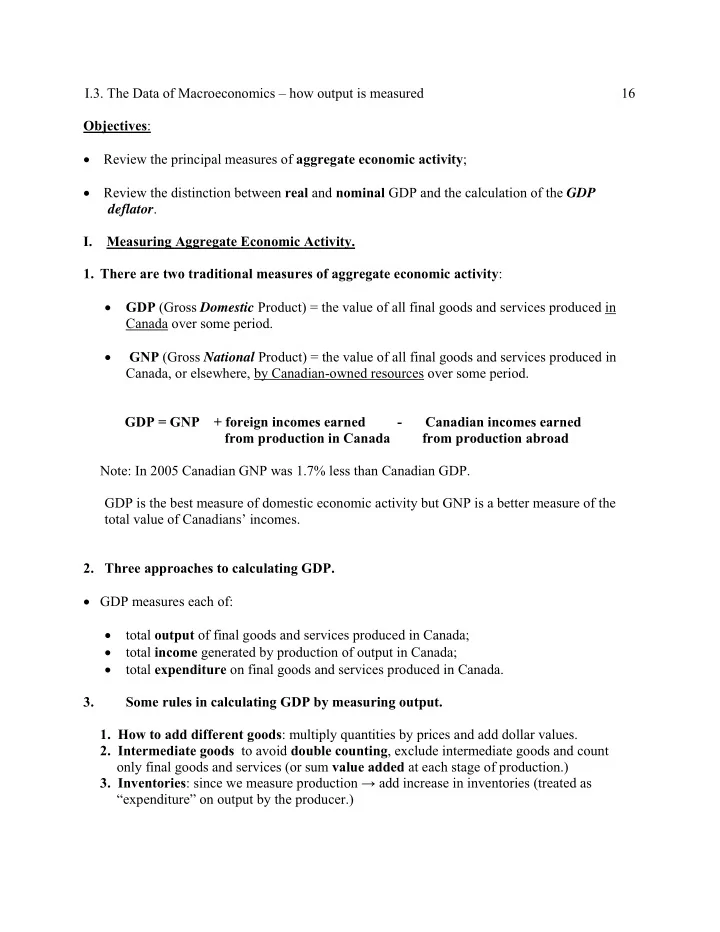

I.3. The Data of Macroeconomics – how output is measured 16 Objectives : Review the principal measures of aggregate economic activity ; Review the distinction between real and nominal GDP and the calculation of the GDP deflator . I. Measuring Aggregate Economic Activity. 1. There are two traditional measures of aggregate economic activity : GDP (Gross Domestic Product) = the value of all final goods and services produced in Canada over some period. GNP (Gross National Product) = the value of all final goods and services produced in Canada, or elsewhere, by Canadian-owned resources over some period. GDP = GNP + foreign incomes earned - Canadian incomes earned from production in Canada from production abroad Note: In 2005 Canadian GNP was 1.7% less than Canadian GDP. GDP is the best measure of domestic economic activity but GNP is a better measure of the total value of Canadians’ incomes. 2. Three approaches to calculating GDP. GDP measures each of: total output of final goods and services produced in Canada; total income generated by production of output in Canada; total expenditure on final goods and services produced in Canada. 3. Some rules in calculating GDP by measuring output. 1. How to add different goods : multiply quantities by prices and add dollar values. 2. Intermediate goods to avoid double counting , exclude intermediate goods and count only final goods and services (or sum value added at each stage of production.) 3. Inventories : since we measure production → add increase in inventories (treated as “expenditure” on output by the producer.)
I.3. The Data of Macroeconomics – how output is measured 17 4. Imputations : if goods do not have prices → use imputed value imputed rent on owner-occupied housing; government services - valued at cost. 5 . Exclusions from GDP: used goods; home production; underground economy; services of durable goods (fridge); environmental effects of production. II. Real and Nominal GDP. Nominal GDP = output valued at current-period prices: � � � � ���� � ���� � where: � ���� � is the price of good i in 2010; � ���� � is the quantity of good i produced in 2010 Nominal GDP measures the value of goods and services produced in Canada. Real GDP = output valued at constant (base year, for example 2002 ) prices: � � � � ���� � ���� � Real GDP measures the volume of goods and services produced in Canada. III. The GDP Deflator Definition: The GDP deflator is a price index which measures the average price of output relative to its level in the base year. 2. Calculation of GDP Deflator: ��� �������� � ������� ��� ���� ���
I.3. The Data of Macroeconomics – how output is measured 18 So: Nominal GDP = Real GDP x GDP Deflator IV. The Components of Aggregate Expenditure C - consumption : goods and services bought by consumers I - investment : goods bought for future use: business fixed investment residential investment inventory investment Exclude: existing things (purchase of an existing factory) claims to existing things (stocks and bonds). G - government purchases of goods and services, all levels of government Exclude: govt spending on transfer payments e.g. CPP benefits, EI benefits, welfare. NX - net exports = exports - imports. National Accounts Identity : Y ≡ C + I + G + NX ( Y = GDP) Note : Output is identically equal to actual expenditure because goods produced and put into inventory for future sale are treated as being “purchased” by the producer. V. Various Measures of Income. The principal measure of aggregate income is National Income which can be derived from GDP in three steps as follows: 1 . GNP (Gross National Product) = GDP - Net Income of Foreigners. Why subtract net income of foreigners? Because we wish to calculate Canadian income. 2 . NNP (Net National Product) = GNP - Depreciation. Why subtract depreciation? Capital gets used up in the production process. That’s a cost of
I.3. The Data of Macroeconomics – how output is measured 19 production which does not result in income to the factors of production. 3. National Income = NNP - Indirect Business Taxes (e.g. GST, PST) Why subtract indirect business taxes? Because firms (or their workers/shareholders) do not receive indirect taxes as income.
Recommend
More recommend